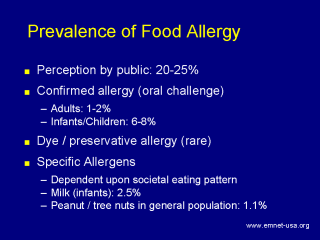 |
Although 20-25
percent of the general public believes that they have a food allergy,
population studies employing oral food challenges have indicated that 1-2
percent of adults and 6 to 8 percent of children have food allergy. Adverse
reactions to food dyes or preservatives are much less common (<1%). The
prevalence of allergy to a specific food proteins is dependent upon societal
eating patterns. For example, fish allergy is more common in Scandanavian
countries. Population studies have determined that milk allergy effects 2.5
percent of infants and 1.1 percent of the general population of the United
States has peanut or tree nut allergy. |
